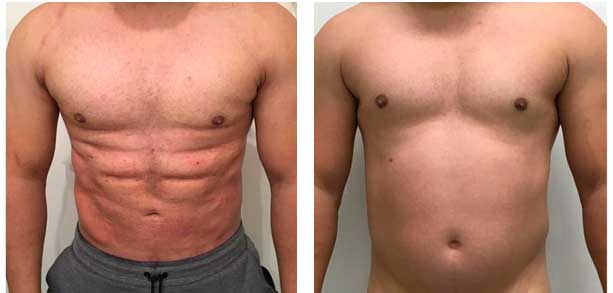If you have been working out consistently at the gym, maintaining a healthy diet, and no matter how hard you try you still can’t achieve those six-pack abs you crave, you are not alone. For many people, genetic factors, persistent fat deposits and skin elasticity can prevent the abdominal muscles from showing, no matter how dedicated they are to their exercise routine. This is where abdominal etching becomes an option.
Abdominal etching, also known as ab etching or high-definition liposuction, is a cosmetic surgical procedure designed to improve the appearance of the abdominal muscles. Unlike traditional liposuction, which simply removes fat, abdominal etching strategically sculpts fat around the natural contours of the abdominal muscles, creating a more defined six-pack look.
This advanced body contouring technique has gained popularity over time among fitness enthusiasts, bodybuilders, and people who want to achieve a more toned and athletic physique without spending so many hours inside a gym. Below, we’ll find out everything you need to know about abdominal etching, from how the procedure works to recovery expectations and whether it might be right for you.
What is abdominal etching?
Definition
Abdominoplasty is a specialized form of liposuction that targets small, strategic areas of fat in the abdomen. Unlike traditional liposuction, which simply removes fat deposits, abdominoplasty is a precise procedure that removes fat in a meticulous and selective way to highlight the natural muscular anatomy.
The main objective of abdominal etching is to create the appearance of a more defined and athletic abdomen by improving the visibility of the abdominal muscles (the “six-pack” muscles) and the oblique muscles on the sides of the abdomen. The result is a more muscular appearance that mimics the look of well-developed abs.
History and development of the procedure
Abdominal etching was first introduced in the 1990s, when specialist surgeons began to improve liposuction techniques to achieve more defined results. Over the years, the procedure has evolved significantly with technological advances and surgical techniques.
Today, modern tummy tuck procedures use high-definition liposuction technologies that allow for more precise fat removal and muscle definition. Surgeons now use smaller cannulas (the thin tubes used for liposuction) and more advanced imaging techniques to ensure precise, natural-looking results.
How does abdominal etching work?

The surgical technique
Abdominal etching is usually performed as an outpatient procedure under local anesthesia with sedation or general anesthesia, depending on the patient’s preferences and the surgeon’s prior recommendation. Here is a step-by-step breakdown of how the procedure works:
- Preoperative marking: Before starting the operation, the surgeon carefully marks the patient’s abdomen while standing to identify the natural lines of the abdominal muscles. This step is very important and serves as a roadmap during the operation.
- Administration of anesthesia: Local anesthesia with sedation or general anesthesia is administered to ensure the patient’s comfort during the procedure and thus avoid pain or discomfort.
- Placement of incisions: The specialist makes small, strategically placed incisions (usually 2-4 mm in length) around the abdomen, often hidden inside the navel or along the natural folds of the body.
- Injection of tumescent solution: A tumescent solution containing saline, lidocaine (a local anesthetic) and epinephrine (to reduce bleeding) is injected into the target areas.
- Fat removal and sculpting: Using specialized cannulas, the surgeon carefully removes fat from certain areas and preserves it in others to create the desired muscular appearance. The surgeon follows the natural anatomy of the abdominal muscles, removing fat from the grooves between the muscle groups and leaving a thin layer of fat over the muscles themselves.
- Final contouring: The surgeon makes the final adjustments to ensure symmetry and natural-looking results.
- Closure: The small incisions are closed with sutures that will dissolve on their own or be removed during a follow-up appointment.
Advanced techniques and technologies
Modern procedures for abdominal etching often incorporate advanced technologies to improve results:
- VASER (Vibration Amplification of Sound Energy at Resonance): This ultrasound technology helps break down fat cells before removal, allowing for more precise sculpting.
- Power-assisted liposuction (PAL): This technique uses a vibrating cannula to break up fat, facilitating its removal and reducing trauma to surrounding tissue.
- Laser-assisted liposuction: Some surgeons use laser technology to melt the fat before extraction, which can result in tighter skin and more defined results.
Ideal candidates for abdominal etching
Who should consider abdominal etching?
The best candidates for abdominal etching are people who:
- Are within 10-15% of their ideal body weight.
- Already have good muscle tone but lack definition due to a thin layer of subcutaneous fat.
- Have good skin elasticity.
- Lead a healthy lifestyle, with regular exercise and a balanced diet.
- Have realistic expectations about the results.
It is important to know and point out that abdominal etching is not a weight loss procedure, as another procedure such as gastric sleeve or gastric bypass would be, but a body contouring technique. The ideal candidate already has a relatively low body fat percentage and good muscle development that is simply hidden by a layer of stubborn fat.
Who should avoid abdominal etching
Abdominoplasty may not be suitable for people who:
- Have a high percentage of body fat or a significant amount of weight to lose.
- Have inelastic skin.
- Have undergone several previous abdominal surgeries.
- Suffer from certain medical conditions, such as heart disease, diabetes or bleeding disorders.
- Smoke.
- Have unrealistic expectations about the results.
A thorough consultation with a board-certified plastic surgeon is essential to determine if you are a good candidate for this procedure.
Advantages and risks of abdominal etching

Advantages of choosing abdominal etching
- Greater definition: The procedure can create a more athletic and sculpted appearance that may be difficult or impossible to achieve through diet and exercise alone in many cases.
- Selective fat removal: Unlike diet and exercise, which reduce fat throughout the body, abdominal etching allows for precise fat removal from specific areas.
- Lasting results: When maintained with a healthy lifestyle, the results of abdominal etching can be long-lasting, it is important to follow the specialists’ recommendations.
- Minimal scarring: The procedure requires only small incisions that normally heal with minimal visible scarring.
- Relatively quick recovery: In most cases, patients can return to work in 7 days and resume all activities in 4-6 weeks.
Potential risks and complications
Like any surgical procedure, abdominal etching carries certain risks:
- Infection: Although rare, infections can occur at the incision sites.
- Contour irregularities: Irregular fat removal can result in lumps, bumps, or asymmetry.
- Seroma or hematoma: Fluid or blood can accumulate under the skin.
- Scarification: Although the incisions are small, some patients may develop more noticeable scars.
- Changes in sensitivity: Some patients experience temporary or permanent changes in the sensitivity of the skin around the treated areas.
- Dissatisfaction with results: If expectations are not managed properly, patients may be dissatisfied with their results.
- Anesthesia-related complications: Although rare, there are risks associated with anesthesia.
The abdominoplasty procedure: What to expect
Consultation and planning
The abdominoplasty procedure begins with a thorough medical consultation with a board-certified plastic surgeon. During this initial meeting:
- The surgeon will assess your general state of health, your body type and the elasticity of your skin.
- You will discuss your goals and expectations.
- The surgeon will explain the procedure in detail, including the possible risks and limitations.
- Preoperative photographs will be taken to plan and compare the before and after.
- You may be offered the option of combining tummy tuck with other procedures, such as traditional liposuction or abdominoplasty.
Based on this evaluation, your surgeon will develop a personalized surgical plan tailored to your anatomy and desired aesthetic goals.
Preparing for surgery
In the weeks leading up to your tummy tuck procedure, you should:
- Maintain a stable weight through a healthy diet and exercise.
- Stop smoking at least 6 weeks before the procedure.
- Avoid certain medications and supplements that can increase the risk of bleeding, such as aspirin, anti-inflammatories, and certain herbal supplements.
- Arrange for someone to take you home after the operation and to help you during the first 24-48 hours of recovery.
- Prepare your recovery space with everything you need.
- Follow the specific preoperative instructions previously given to you by your surgeon.
The day of the operation
The day of the abdominal etching procedure:
- The surgery usually lasts between 1-3 hours, depending on the extent of the procedure.
- You will be able to go home the same day, as abdominal etching does not require you to stay in the facility for a long time.
- You will be given a compression garment to wear before leaving the surgical center.
Recovery and results

Immediate postoperative period
The first few days after abdominal etching can be uncomfortable. This is what you can expect:
- Swelling, bruising and pain in the treated areas.
- You may need painkillers for the first few days.
- You will need to wear a compression garment 24 hours a day, 7 days a week (except when showering) for the first 2-4 weeks to reduce swelling and help the skin adapt to its new contour.
- Limited physical activity, although walking is recommended to promote circulation.
Timeline for long-term recovery
Full recovery from abdominal etching follows the general schedule below:
- 1 week: Most patients can return to office work and light activities.
- 2 – 3 weeks: Bruising usually disappears.
- 3 – 4 weeks: Most patients can resume moderate exercise (avoiding direct abdominal exercises).
- 6 weeks: All activities can normally be resumed, including abdominal exercises.
- 3 months: Most of the swelling subsides and the initial results become visible.
- 6 months to 1 year: The final results develop as the swelling subsides and the tissues settle.
How to maintain the results
To maintain the results of abdominal etching in the long term
- Follow a consistent exercise routine that includes both cardiovascular exercise and strength training.
- Maintain a stable weight through a balanced diet.
- Stay well hydrated.
- Avoid significant weight fluctuations, which can alter the results.
- Attend regular follow-up appointments with your surgeon to monitor the results.
It is vital to bear in mind that, although the fat removed during abdominal etching disappears permanently, weight gain can affect the results, as the remaining fat cells can expand.
Costs and considerations
Average cost
The cost of abdominal etching can vary significantly depending on several factors, including:
- Geographical location.
- Experience and expertise of the surgeon.
- Center fees.
- Anesthesia costs.
- Postoperative care and garments.
On average, abdominal etching costs between $3,000.00 and $8,000.00 in the United States. However, prices can be higher in large metropolitan areas or when performed by renowned surgeons.
It is important to bear in mind that abdominal etching is considered a cosmetic procedure and is not usually covered by medical insurance.
Factors affecting cost
Several factors can influence the total cost of your abdominal etching procedure:
- Extent of the procedure: A more extensive sculpture or treatment of a larger area will generally cost more than a smaller one.
- Combined procedures: If an abdominal etching is performed together with other procedures such as traditional liposuction or a tummy tuck, the total cost will be higher.
- Surgeon’s experience: Surgeons with more experience and specialized training in high-definition liposuction tend to charge more.
- Geographic location: Prices tend to be higher in areas with a higher cost of living, such as New York, Los Angeles and Miami or the state of California.
- Type of center: The type of center where the procedure is performed (hospital, outpatient surgery center or operating room) can influence the cost.
Financing Options
Many plastic surgery clinics offer financing options to help make tummy tucks more affordable:
- Medical credit cards (such as CareCredit).
- In-house financing plans.
- Personal loans.
- Health savings accounts (HSAs) or flexible spending accounts (FSAs) in some cases.
When researching costs, be sure to ask what is included in the quoted price and if financing options are available. This will help you keep a more accurate track of the additional payments you may have to make in some cases.
Choosing the right surgeon
Credentials to look for
Choosing the right surgeon is perhaps the most important decision on your journey to a flatter stomach. Look for:
- Certification by the American Board of Plastic Surgery.
- Specific training and experience in body contouring and high-definition liposuction.
- Membership of professional organizations such as the American Society of Plastic Surgeons (ASPS) or the American Society for Aesthetic Plastic Surgery (ASAPS).
- Hospital privileges at accredited centers.
- History of regularly performing abdominal etching procedures.
Questions to ask during the consultation
During your consultation, consider asking the specialist these important questions:
- “How many tummy tuck procedures have you performed?”
- “Can I see before and after photos of your previous tummy tuck patients?”
- “What complications have you encountered with this procedure, and how were they managed?”
- “What type of anesthesia will be used?”
- “Where will the procedure be performed?”
- “What is your approach to follow-up care?”
- “What can I realistically expect in terms of results?”
- “What happens if I am not satisfied with my results?”
Red flags to look out for
Be careful if you encounter any of these warning signs:
- Extremely low prices that seem too good to be true.
- Pressure to make a quick decision or to sign up for several procedures.
- Vague answers to specific questions about experience and credentials.
- Absence of before and after photos of previous patients.
- Procedures performed in non-accredited centers.
- Little or no information about possible risks and complications.
- Guarantees of perfect results.
Abdominal etching vs. alternative options
Non-surgical alternatives
For those who are not ready for surgery, several non-surgical options can help improve abdominal definition:
- Specific exercise programs: Specific core strengthening exercises can help develop abdominal muscles, although they may remain hidden under fat without a proper diet.
- Professional nutritional coaching: Working with a nutritionist to develop a personalized nutrition plan can help reduce body fat percentage.
- Non-invasive fat reduction: Technologies such as CoolSculpting, SculpSure or Emsculpt can reduce fat or improve muscle tone without surgery, although the results are usually less dramatic than surgical options.
Other surgical options
Alternative surgical procedures to consider include:
- Traditional liposuction: Removes larger volumes of fat but without the precise muscle definition of abdominal etching.
- Tummy tuck: Treats loose skin and separated abdominal muscles, as well as removing fat. It is usually recommended for patients who have experienced significant weight loss or pregnancy.
- Mini-tummy tuck: Less extensive than a full tummy tuck, focusing only on the lower abdomen.
- Combined procedures: Some patients benefit from a combination of procedures, such as tummy tuck with abdominal etching, for optimal results.
Real patient experiences
Success stories
Many patients are very satisfied with the results of tummy tucks. The most common positive comments include:
- Increased confidence in a shirtless or swimsuit
- A more defined appearance that motivates continued healthy habits
- Results that look natural, not “surgically created.”
- Long-lasting definition if maintained with proper diet and exercise.
Realistic expectations and results
It is important to maintain realistic expectations about abdominal etching:
- Results vary depending on individual anatomy, skin elasticity and pre-existing muscle tone.
- The procedure improves existing muscles, but does not create them where they do not exist.
- Some asymmetry may persist, as it is normal in natural anatomy.
- Final results take time to develop, as the swelling resolves over several months.
- Long-term maintenance requires leading and maintaining a healthy lifestyle.
Frequently asked questions about abdominal etching
Frequently asked questions and expert answers
Will the results of abdominal etching look natural?
When performed by an experienced surgeon, tummy tuck results should appear natural and enhance existing anatomy, rather than creating an artificial look.
Can tummy tuck be combined with other procedures?
Yes, tummy tuck is often combined with traditional liposuction, abdominoplasty or other body contouring procedures for comprehensive results.
Is recovery from abdominal etching painful?
Most patients describe recovery as moderately uncomfortable rather than extremely painful. Discomfort is typically manageable with prescription pain medication for the first few days, followed by over-the-counter pain relievers.
Will I have visible scars after abdominal etching?
The incisions made during the abdominal etching are very small (2-4 mm) and are strategically placed in inconspicuous areas, such as the navel or natural folds of the body. Once healed, these scars are usually barely noticeable.
Will I have to wear a compression garment and for how long?
Yes, the use of a compression garment is essential for optimal results. Most surgeons recommend wearing it 24 hours a day, 7 days a week (except when showering) for 2-4 weeks, and then during the day for another 2-4 weeks.
How soon can I return to work after abdominal etching?
Most patients can return to light office work in 5-7 days. Jobs that require physical activity and greater exertion may require 2-3 weeks of rest.
Can I exercise after abdominal etching?
Light walking is recommended immediately after the procedure to promote circulation. Most patients can resume cardiovascular exercise (except high impact activities) after 2-3 weeks and full exercise including abdominal exercises after 6 weeks, with the surgeon’s approval.
Will pregnancy or weight gain affect my results?
Significant weight gain or pregnancy after abdominal etching can alter your results by expanding the remaining fat cells. For this reason, some surgeons recommend waiting until after you have completed your family before undergoing this procedure.
Important
Abdominal etching offers a specialized solution for people who are already fit but struggle to achieve visible abdominal definition due to stubborn fat deposits located specifically in the abdominal area. This advanced liposuction technique can create the appearance of a more defined six-pack by strategically removing fat to highlight natural muscle anatomy.
Although the procedure can deliver impressive results for the right candidates, it is important to approach abdominal etching with realistic expectations. It is not a weight loss solution or a substitute for healthy habits, but rather a body contouring procedure that enhances existing muscle tone.
Successful tummy tuck begins with choosing a qualified, experienced, board-certified plastic surgeon who specializes in high-definition liposuction techniques. Through careful consideration of your goals, anatomy and lifestyle, your surgeon can help you determine if tummy tuck is right for you and develop a personalized treatment plan to help you achieve the defined, athletic abdomen you desire.
Remember that to maintain the results in the long term it is necessary to commit to a healthy lifestyle with regular exercise and proper nutrition. With the right approach, abdominal etching can be a valuable tool in achieving the defined abdominal contours that might otherwise remain elusive despite your best efforts in the gym.






